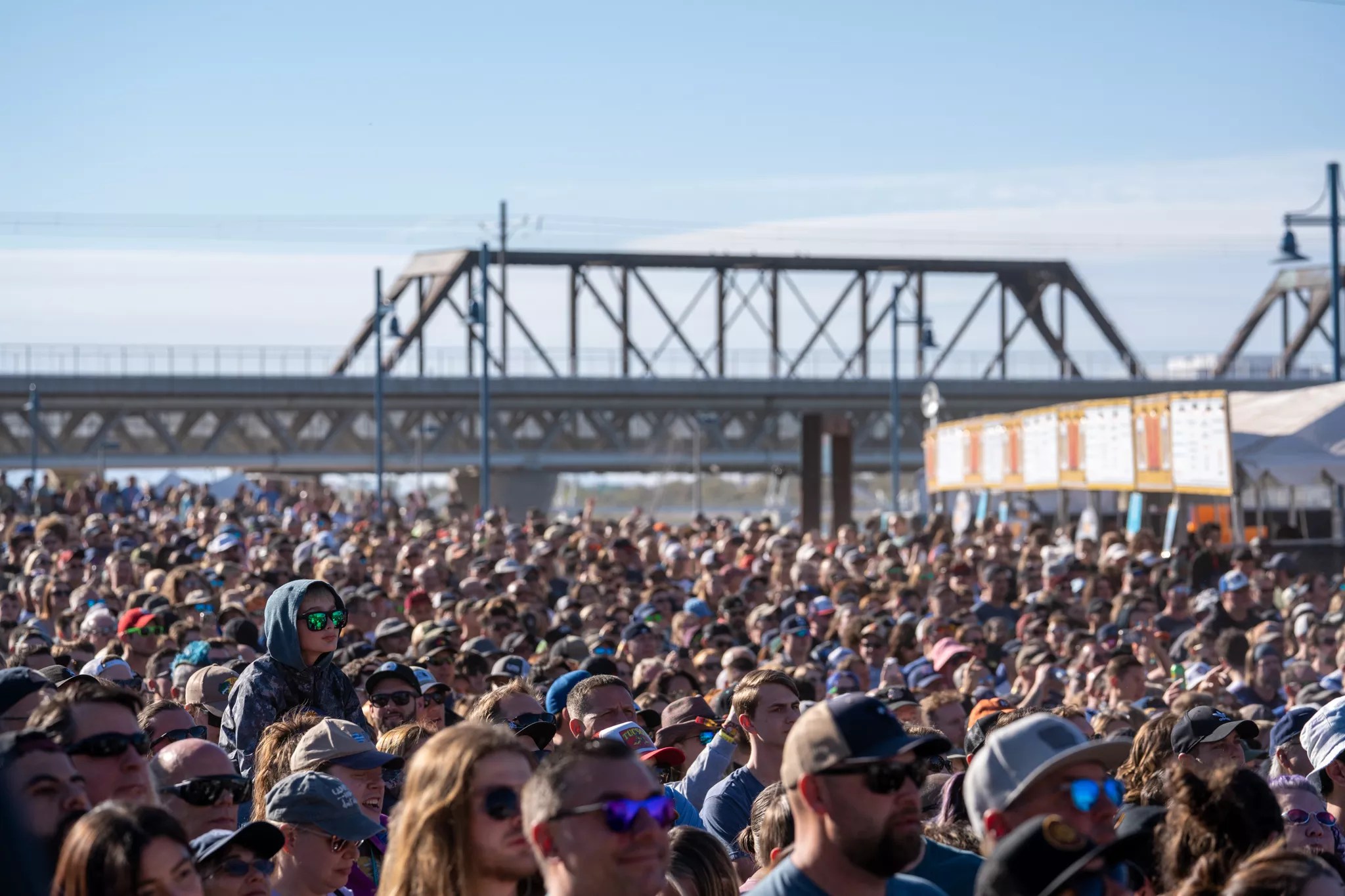
Angela Rose Photography

Audio By Carbonatix
Living in Phoenix teaches you a lot about being nimble.
Which is to say, you’ve got to work with what’s available in order to be successful. When the desert giveth, you’ve got a surplus of beauty and resources. And when the desert taketh, you’ve got to cinch the old belt and learn to do without.
That’s certainly proven true for music festivals.
A lot has been written in this publication, especially by this writer, about the ongoing cultural and economic promise of these festivals. How they generate the sort of energies and structures that bring attention to the Valley’s scene; demonstrate our shared value in the scheme of the national tour infrastructure; and affirm our status as a top-tier city for arts and culture. Sure, there are other events and institutions capable of facilitating this “feat,” but it’s fests that feel like that glowing road sign toward sustainable prosperity.
This year, make your gift count –
Invest in local news that matters.
Our work is funded by readers like you who make voluntary gifts because they value our work and want to see it continue. Make a contribution today to help us reach our $30,000 goal!
Over the years, the festival scene in the Valley has undergone its own, continuous transformation. As recently as just a few years ago, the state had M3F, Innings, Lost Lake, Viva PHX, FORM, and Country Thunder, among a few other, more regional offerings. It was a boom period for our fair state, and it made us a beacon of great music across the Southwest.
But then COVID happened, and whether directly related to the pandemic itself, we lost roughly half of those events. (Other fests, like Pot of Gold, closed for other reasons around the same timeframe.) It seems like crying when you’ve only spilled half your milk, but when you live in a city where the plague of SB 1070 and its near-ruination of the music scene remains very much fresh, it’s hard not to reel accordingly.
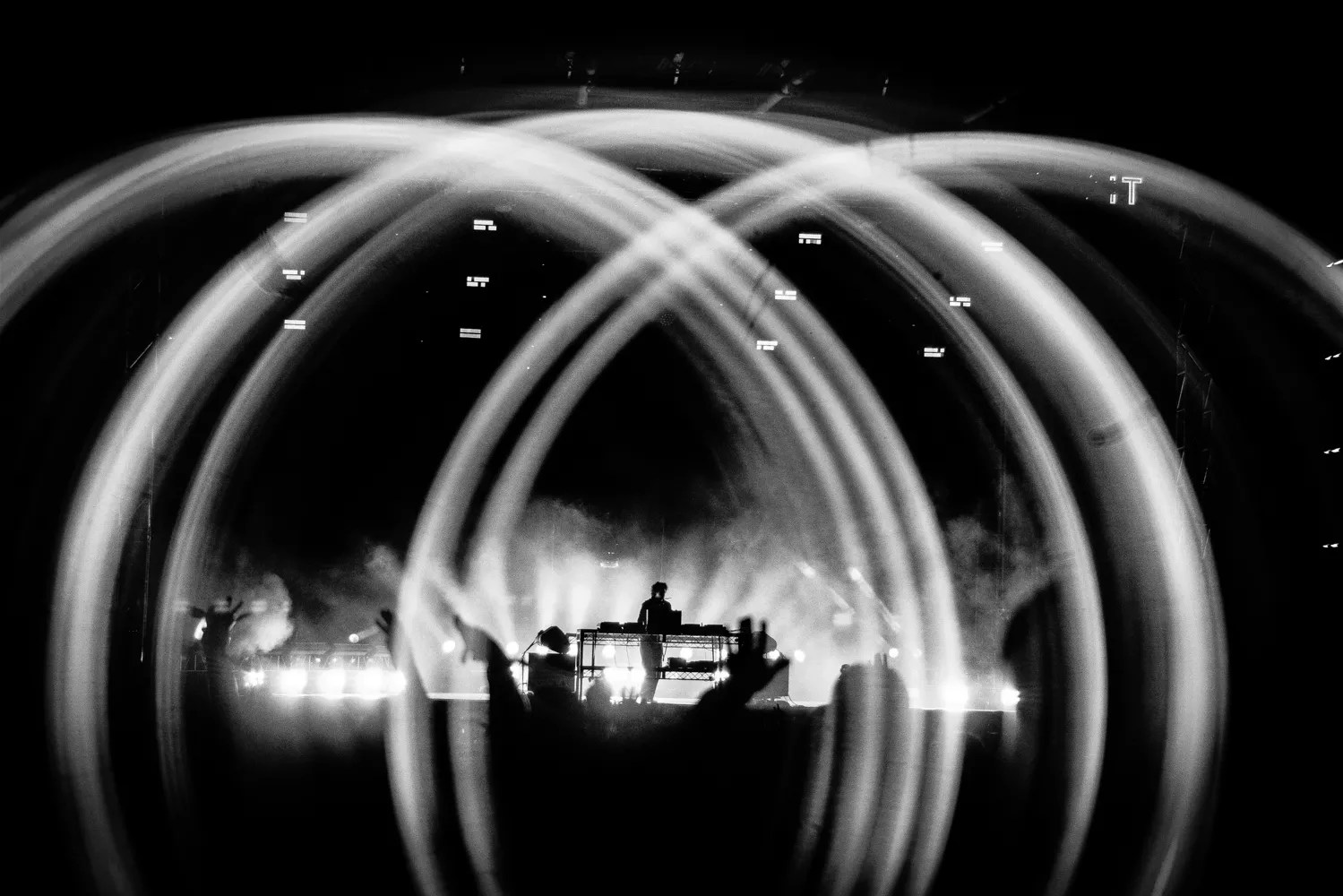
Jamie xx closes out night two (March 4) of M3F 2023.
Jim Louvau
Luckily, everything eventually blooms in the desert, and not only have fests like M3F, Innings, and Country Thunder returned to full capacity, but a new fest, ZONA, launched in late 2022. There’s also Dream Master Mixtape, a new Yuma-based fest from rapper Mega Ran slated for mid-May, and that same month, Prescott will hold the second annual Pure Imagination Festival. This fall, some of the organizers of the late, great, Apache Lake Music Festival are returning with a new concept, the Luna Del Lago Festival. It would seem that if we haven’t returned entirely to that same pre-COVID “boom period,” we’re experiencing something like springtime.
Things are, by no stretch of the imagination, at all perfect. We haven’t reached the status of a place like Chicago, whose mix of mega-fests like Lollapalooza and other regional entries bolsters its power as a destination for the arts. And because we’ve lost so much before, our current festival “roster” is colored by this notion that everything could change year to year. It’s with that in mind that we need a proper change of thinking. Back in December, Phoenix New Times published a piece about maintaining cautious optimism around the debuting ZONA, and that feels like the proper temperament for surviving in the desert.
Because it’s ill-advised to operate under the assumption that our ascendence onto the national arts scene will always happen in fits and starts. Long-running outings like M3F and Country Thunder, the latter of which has slowly become a big deal for the robust American country music scene, proves that our state has the pedigree for long-term success. The fact that we keep developing new fests, even as other states still grapple with axed fests from amid COVID, demonstrates that there is clear value in something about our geography, culture, and temperature (socially but also physically) to organizers.
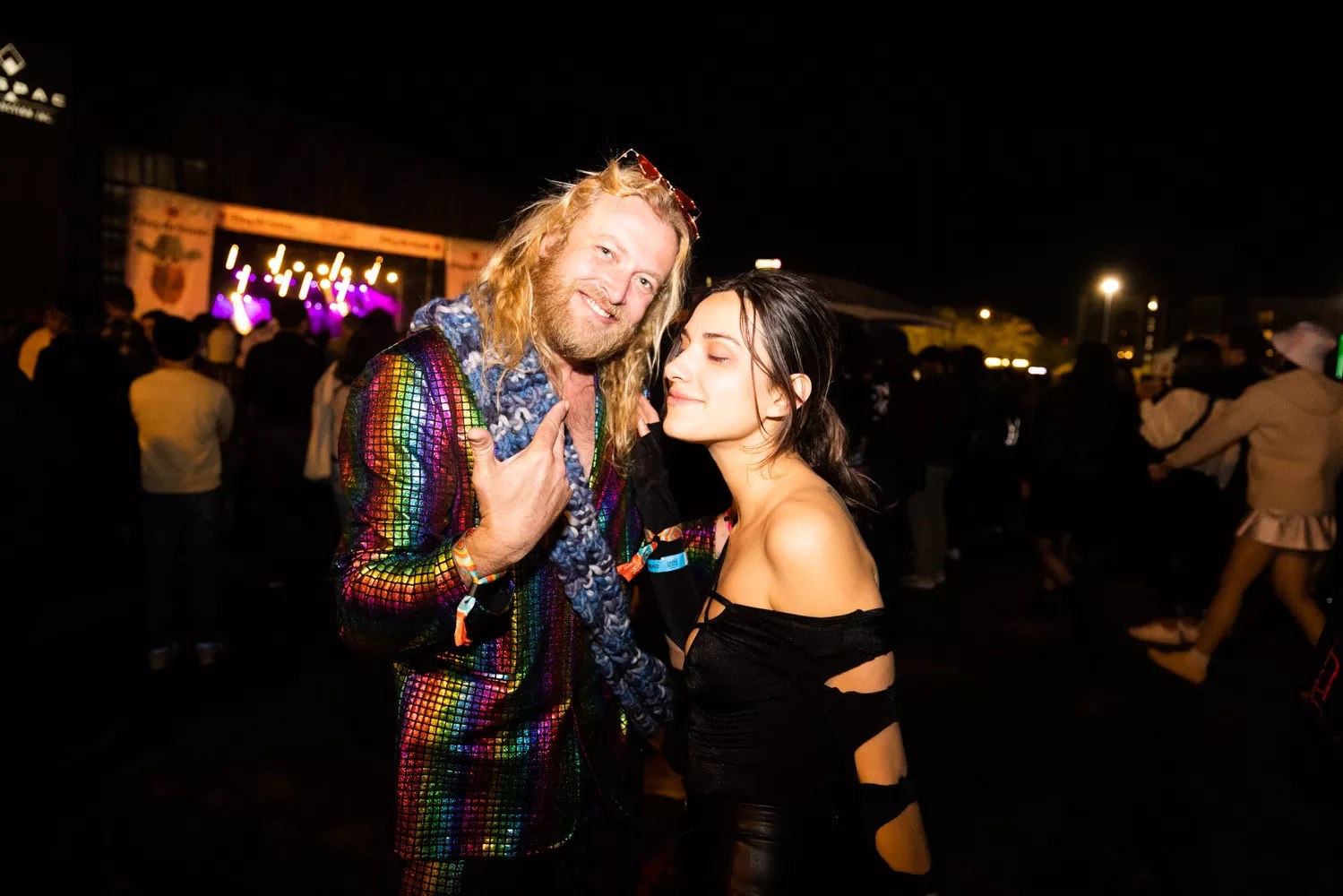
Two festivalgoers pose during night two of M3F 2023.
Jim Louvau
But there are also some larger, more definitive signs that the festivals we do have across Arizona are fostering something more than simply good times. For one, ZONA reversed a trend among fests like M3F and Innings to include more local bands/artists. If that fest can sustain its momentum beyond year one, then there’s a good chance it can raise its profile to better match these more established events (and, in the case of Innings, its national status thanks to big-time organizers C3 Present). Plus, more local acts just means these bands get the spotlight needed to help their own careers in a big way.
There’s more to that local angle, too. Where events like M3F and Innings still clearly struggle with connecting with our scene (i.e., the lack of local talents= has always felt like a glaring blind spot), there’s been some noticeable inroads. M3F, for instance, books a handful of local acts, and giving up-and-comers like Slug Bug a spotlight in 2023 is vital for offering bands a new platform while motivating them to consider these fests as viable career paths. The fact that the locals were “limited” might be a form of curation that could help balance out these events (although who knows if that’s entirely true).
Beyond the lineups themselves, there are other, equally promising developments. If you’re someone who attended ZONA, Innings, M3F, and Country Thunder (maybe all four?!) in the last year or two, you might have noted that things are as efficient as ever. Any big concerns – sound issues, re-entry policies, overpriced menus, etc. – are annoying but often problematic across the entire national festival scene. Is it maybe a post-COVID sense of streamlining? Sure. But, tackling past problems to deliver a more engaging and convenient experience for fans is still a triumph. It’s a collective achievement that empowers the whole scene, and elevates things to make these events feel collectively like a proper destination.
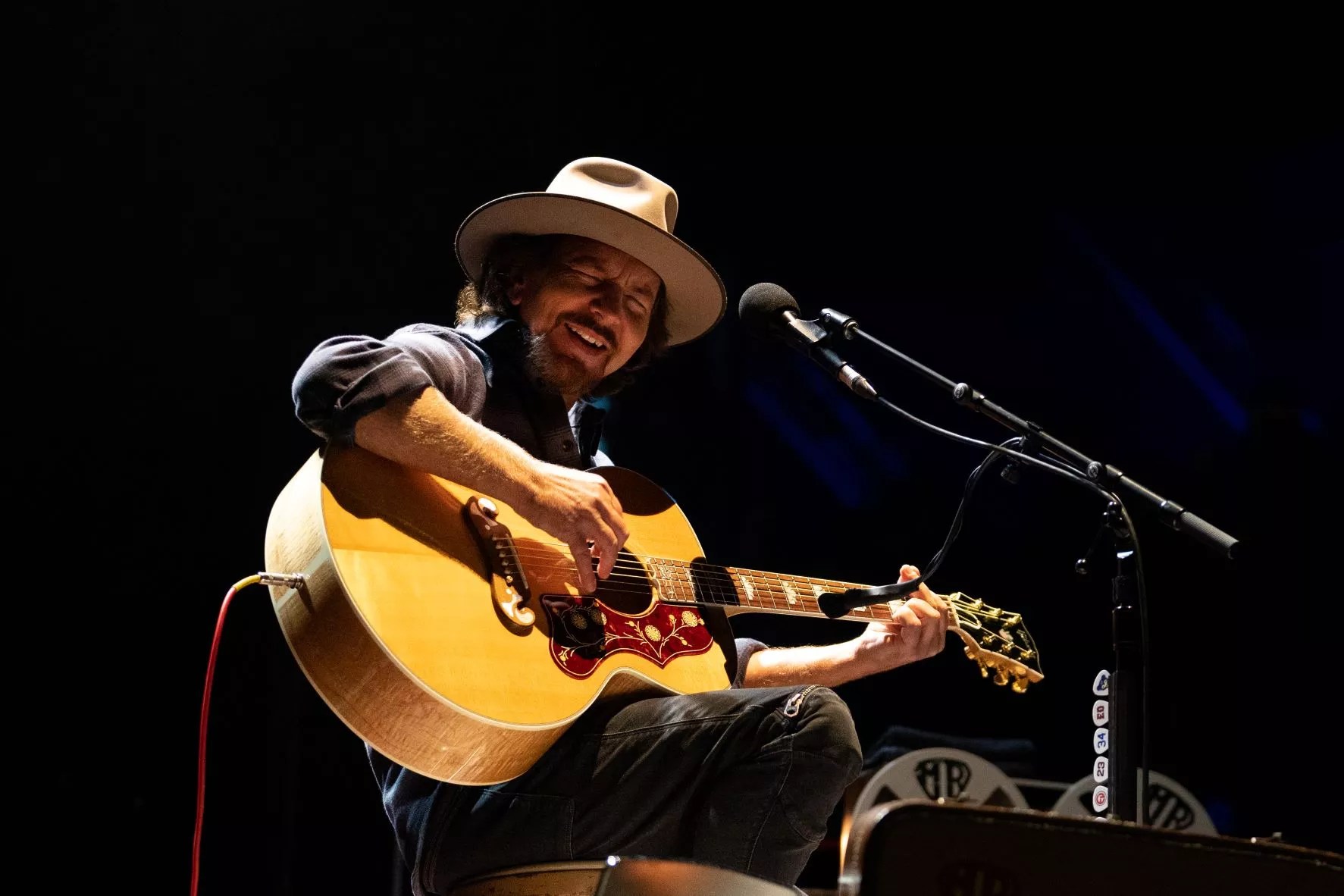
Eddie Vedder performs at Innings Festival on February 26, 2023.
Angela Rose Photography
Additionally, many fans at these events have been hungrier than ever, and that makes for a better all-around experience. (Even if that’s just a COVID-related side effect, it might stick given that folks have seen what happens when fests vanish.) We’ve also gotten some big-name acts, including Foo Fighters and Green Day at the 2022 and 2023 editions of Innings, respectively. These two, especially, feel like big, clear wins – clear confirmation of the sort of acts that should be here already. It’s also worth noting, as ticket prices skyrocket nationwide, fests are an “affordable” way to see big-time acts.
Still, there’s a huge sign that’s perhaps not quite as concrete and/or definitive. Without anything beyond a well-honed hunch, fests have to be some of the key reasons that we’re a viable spot for the launch of Taylor Swift’s latest mega-tour. (Sure, there are the more obvious logistical reasons, but the timing itself just feels too perfect for a mere convenience.) Even if it’s not the case, the end results feel mostly the same: Things are happening here, and we’re becoming increasingly viable to the industry at large as a musical haven – even if it’s just when the sun is shining and/or on the way to other musical meccas.
At the same time, there exists that undercurrent that things could always and irredeemably change. That next year’s Innings could feature a “lesser” star, or that the Swift launch was mostly a fluke. It’s essential not to ignore those feelings given how utterly true they’ve proven in the past. Our scene remains tenuous even to this day, and there’s no denying that the spirit of bad politics – a la the aforementioned SB 1070 – absolutely could strike again. (Especially in this age of increasingly awful policies enacted nationwide that affect a city’s arts and music scene, as with drag bans in Tennessee.) Same goes for that notion that we haven’t clearly and abundantly benefited from a post-COVID bump and things might shift as the industry continues to reconfigure.
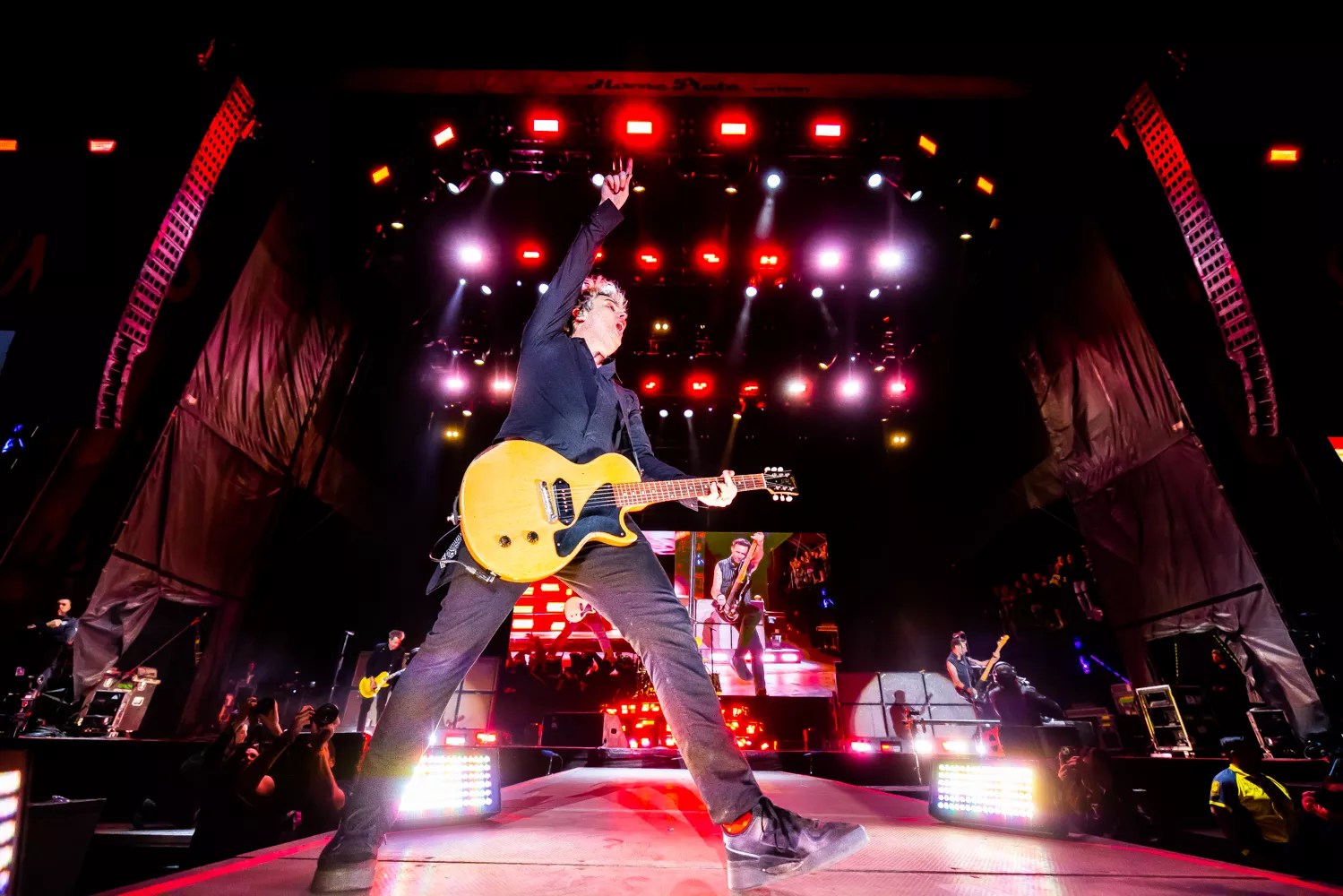
Green Day closes out the first day of Innings Festival 2023.
Jim Louvau
To ignore these “fears” is to ignore the themes of wanting and lacking that define life in these parts. To act like we’ve turned a corner is to ignore that our progress hasn’t always been mired by these half-starts and burnouts in the past. As such, a novel solution is, and as we’ve done this across all other aspects of life, is to remain as nimble as ever. For festivals specifically, it means being grateful for what we have and doing our best as fans, creators, and organizers to sustain that in a way that’s best aligned with our shared values of fairness, openness, and artistic expression.
It also means recognizing the ups and downs of our state, and that fests continue to operate in alignment with those pillars. (For instance, a lot of our fests run in early spring, where pristine temperatures are our friend and U.S. tours are just kicking off, and that’ll continue to be the case.) It’s about not only showing up and fostering a good time, but for the rest of the year supporting local arts and music that serve as an essential bedrock for these fests. Trunk Space, for instance, has the Space Cadet Fest debuting in late May, and that could be another essential layer to our robust music scene while keeping things growing outside the confines of an Innings or M3F. It’s ultimately about supporting some larger ecosystem.
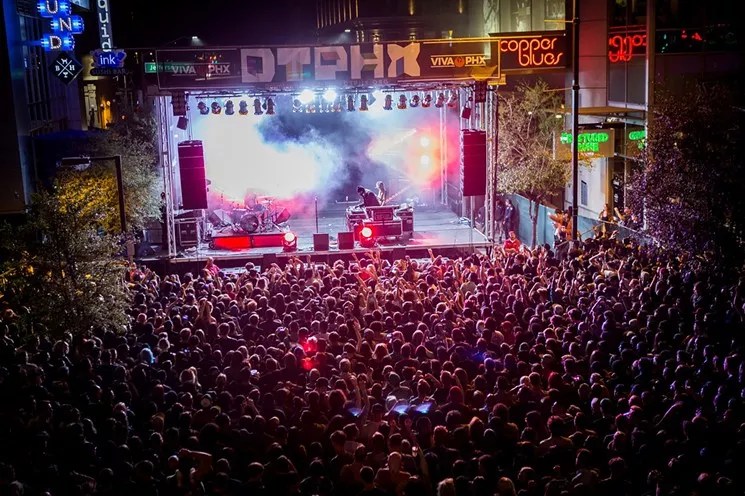
A large crowd during Viva PHX 2016.
Melissa Fossum
But perhaps more than anything else, being nimble means recognizing that we may not get what we want, and that our aforementioned ascendence could always be this moving goal post. A dozen fests alone can’t push a scene into the national conversation, even if that’s something that’s happened to other similarly-sized, culturally diverse cities like ours. Instead, it’s maybe a thing that, while totally possible and a deserving enough fate for Arizona, should be thought of as an ethos or operating statement.
It’s a banner we operate under to keep the state and the “residents” of the arts and culture scene accountable to the ideals of inclusion, variety, and music as a salve, economic workhorse, and force for justice and basic goodness. A lofty goal, for sure, but something that even if it never happens in full means we’re left with this communal structure that commemorates all the things we love about Arizona/Phoenix.
Generating real change can be a momentous task, but this sense of versatility is baked into the collective DNA of Arizona and its residents. If we rely on those ideals even more, we can expect good things – the least of which is a seemingly-endless calendar of live music.